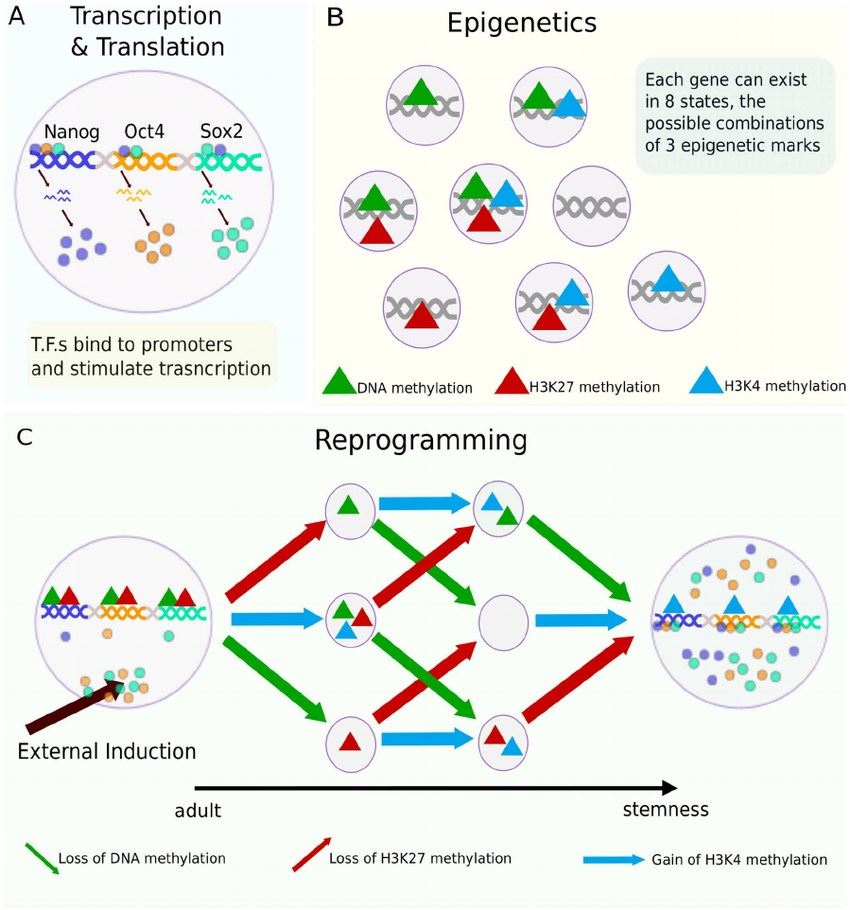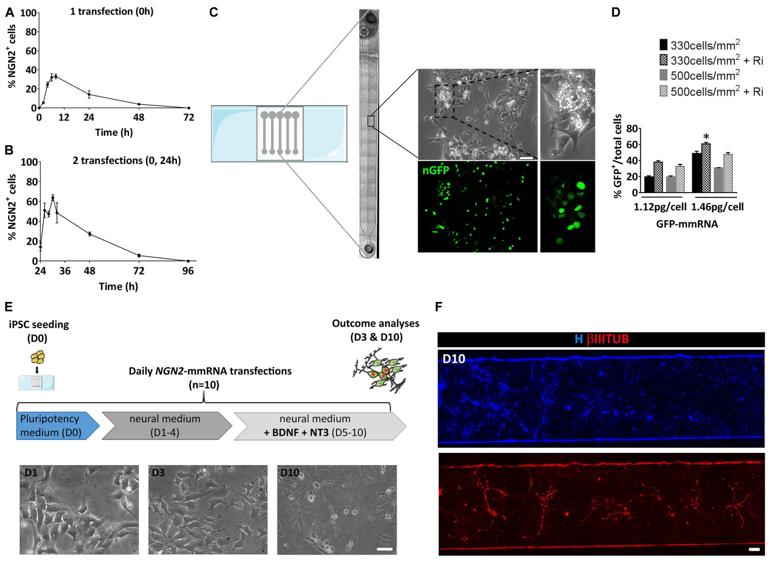Overview Service Features Published Data FAQs Scientific Resources Related Services
Introduction to Factor Delivery by mRNA
Induced pluripotent stem cells (iPSC) have the potential to revolutionize regenerative medicine through their ability to generate cells of diverse lineages for future patient-specific cell-based therapies. Scientists of Creative Biolabs have used almost all available approaches for the delivery of reprogramming factors. RNA reprogramming can be achieved through transfection/transduction of synthetic mRNAs, microRNAs (miRNAs), RNA viruses, or synthetic RNA replicons. Direct delivery of reprogramming RNA (synthetic modified mRNA) can avoid integration of the transgene sequences. To facilitate the transition of iPS cells to clinical practice, a variety of technologies have been developed for transgene-free pluripotency reprogramming in Creative Biolabs, including reprogramming factor delivery by mRNA.
iPS Cell Derivation with Synthetic Modified mRNA
The instability and the relatively short half-life of the modified mRNA, and the fact that iPS cell derivatization typically takes several weeks to complete necessitates that the reprogramming strategy mediated by the modified mRNA will involve repeated administration. However, previous studies have shown that transfection of RNA into mammalian cells leading to severe cytotoxicity due to the activation of innate immune responses by Toll-like receptors (TLR3, TLR7, and TLR8) and RNA sensors (RIG-I and PKR). Incorporation of certain naturally occurring modified nucleosides into mRNA can largely abolish immune activation, such as such as the complete replacement of cytidine and uridine-modified mRNA with modified nucleoside pseudouridine and 5-methylcytidine. It can be repeatedly introduced into cells, where innate immune responses are minimally activated, and cytotoxicity is limited, allowing for stable and sustained protein expression.
 Fig.1 Cellular states and reprogramming.1, 3
Fig.1 Cellular states and reprogramming.1, 3
Properties of Modified-mRNA Technology
The modified-mRNA technology has many properties that make it a powerful platform for guiding cell fate.
-
In many different types of cells, modified mRNA can mediate the robust, penetrant and dose-titratable expression of almost any protein.
-
Since a plurality of different modified mRNA species can be simultaneously introduced into a cell, co-expression of a plurality of proteins can be achieved.
-
The level of any desired factor can be precisely controlled by simply changing the dose of the modified mRNA. This property can be used to explore the stoichiometry of various factors required during reprogramming or directed differentiation experiments.
Services at Creative Biolabs
There is a great need to alter cell fate without altering its genome in many experimental systems and cell therapies. Compared to virus-based methods or DNA plasmids, mRNA has the advantage of high transfection efficiency, without the risk of altering the genome or creating mutational insertions. With 100% success rate, Creative Biolabs is guaranteed to provide highly efficient iPS cell derivation services of different cells with our advanced technology, including reprogramming factor delivery by mRNA. Contact us today to discuss your iPSC project with a technical specialist.
Our iPSC reprogramming factors delivery by mRNA service offers a comprehensive solution for reprogramming somatic cells into pluripotent stem cells.
|
Key Processes
|
Descriptions
|
|
Delivery of Reprogramming Factors
|
-
We are equipped with the advanced tool to transiently transcribe mRNAs encoding key pluripotency transcription factors without any genomic alteration, thereby inducing somatic cells to pluripotency.
-
Our advanced and proprietary lipid nanoparticle delivery system guarantees the effective and efficient delivery of reprogramming factors mRNAs into cells.
|
|
Expression of Reprogramming Proteins
|
-
The mRNAs are translated in the cytoplasm into reprogramming proteins which then induce pluripotency in the target cells turning them into iPSCs.
-
We robustly monitor each step of reprogramming and subsequent culturing, applying stringent quality control measures.
|
|
iPSC Characterization
|
-
We provide robust cell characterization to confirm pluripotency and sterility, ensuring the highest quality of iPSCs.
|
Our expert team provides end-to-end support throughout the process. From initial consultation to determine the best strategy for your specific needs, through delivery of the fully characterized iPSCs, we assure the highest level of quality and customer service.
Features of Our Services
At our company, we specialize in providing innovative solutions for iPSC reprogramming. Our mRNA-based reprogramming approach offers several advantages over traditional methods, including improved safety, efficiency, and flexibility.
-
Customized Reprogramming Factors - We design and produce mRNA molecules encoding the key reprogramming factors necessary for inducing pluripotency in somatic cells.
-
High Efficiency and Safety - mRNA-based reprogramming eliminates the risk of genomic integration associated with viral vectors and our optimized mRNA delivery system ensures high efficiency.
-
Flexible and Scalable - Our approach offers unmatched flexibility, allowing for precise control over reprogramming conditions and protocols. This enables customization to suit various cell types and experimental requirements. Additionally, our service is scalable, accommodating both small-scale research projects and large-scale industrial applications.
-
Expert Support - From experimental design and protocol optimization to troubleshooting and data analysis, we ensure that our clients receive the guidance and assistance they need to achieve their research goals.
Whether you're studying developmental biology, screening potential therapeutics, or developing cell-based therapies, our innovative reprogramming technology can accelerate your research and advance your projects. Partner with us to unlock the full potential of iPSCs in your research and applications.
Published Data
Below are the findings presented in the article related to iPSC reprogramming factors delivery by mRNA.
AM Tolomeo et al. designed a transcription factor-based neural programming using NGN2 modified messenger RNA (mmRNA). To ensure efficient mmRNA delivery, a microfluidic environment developed in their lab was utilized that can significantly increase transfection efficiency in a reprogramming environment. They investigated whether the use of mmRNA-based NGN2 transcription factor delivery methods could support neuronal induction and whether the intrinsically fluctuating nature of mmRNAs derived from routine transfection needs could lead to the generation of multiple neural phenotypes.
 Fig. 2 Setting of the experimental conditions for NGN2 mRNA based transcriptional programming of hiPSCs.2, 3
Fig. 2 Setting of the experimental conditions for NGN2 mRNA based transcriptional programming of hiPSCs.2, 3
It was found that daily transfection of hiPSC with NGN2 mmRNA in a microfluidic system was sufficient to drive neuronal programming, as well as the ability to generate cells with multiple phenotypes along neurodevelopmental trajectories, even in the absence of any small molecules or pattern factors.
FAQs
-
Q: How long does the iPSC reprogramming process take? And What form will the final product take and how will it be delivered?
A: The iPSC reprogramming process usually takes about 2 to 3 weeks from the time we receive your samples. This includes the time spent on quality control to ensure the iPSCs meet our standards before they are shipped to you. The transformed iPSCs are typically provided as live cells in flasks or multi-well plates. The delivery method is often determined on a case-by-case basis, depending on the specific needs and requirements of the customer's project.
-
Q: Can you adjust the genes and delivery according to the specific needs of my research?
A: Absolutely! We have a commonly used gene combination for iPSC reprogramming but we totally understand that each research may have unique requirements. We can tailor our service, from the selection of reprogramming factors to the optimization of delivery regime, to align with the specific requirements of your experiment.
-
Q: Is this method suitable for all cell types?
A: While iPSC reprogramming through mRNA delivery is efficient for many commonly used cells, it might not be the optimal for all cell types. Its effectiveness can be influenced by factors like cellular properties, species, and growth conditions. Consultation with our experts can provide more precise advice on suitability.
-
Q: How do you ensure quality control in the service provided?
A: Quality control is of utmost importance. We utilize rigorous validation procedures, including testing reprogramming efficiency, characterization of iPSCs, and monitoring the sterility and mycoplasma contamination. All results are thoroughly documented to ensure reliability.
-
Q: Does your service include downstream processing and analysis of the reprogrammed iPSCs?
A: Our services are highly customizable and can be extended to include necessary downstream processes like iPSC culture, characterization, and differentiation. This can include pluripotency assays, karyotype analysis, and other functional tests based on what is needed for your particular study.
Scientific Resources
References
-
Gracio, Filipe, Joaquim Cabral, and Bruce Tidor. "Modeling stem cell induction processes." PLoS One 8.5 (2013): e60240.
-
Tolomeo, Anna Maria, et al. "NGN2 mmRNA-based transcriptional programming in microfluidic guides hiPSCs toward neural fate with multiple identities." Frontiers in Cellular Neuroscience 15 (2021): 602888.
-
Distributed under Open Access license CC BY 4.0, without modification.
For
Research Use Only. Not For Clinical Use.
 Fig.1 Cellular states and reprogramming.1, 3
Fig.1 Cellular states and reprogramming.1, 3
 Fig. 2 Setting of the experimental conditions for NGN2 mRNA based transcriptional programming of hiPSCs.2, 3
Fig. 2 Setting of the experimental conditions for NGN2 mRNA based transcriptional programming of hiPSCs.2, 3